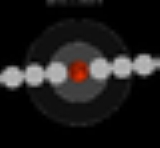
July 2000 lunar eclipse
Encyclopedia
| Total Lunar Eclipse July 16, 2000 |
|
|---|---|
| (no photo) | |
 The moon's path through the Earth's shadow. |
|
| Series (and member) Saros cycle The saros is a period of 223 synodic months , that can be used to predict eclipses of the Sun and Moon. One saros after an eclipse, the Sun, Earth, and Moon return to approximately the same relative geometry, and a nearly identical eclipse will occur, in what is referred to as an eclipse cycle... |
129 (37) |
| Duration (hr:mn:sc) | |
| Totality | 1:47:00 |
| Partial | 3:56:38 |
| Penumbral | 6:17:54 |
| Contacts | |
| P1 | 10:46:38 UTC |
| U1 | 11:57:17 UTC |
| U2 | 13:02:05 UTC |
| Greatest | 13:55:36 UTC |
| U3 | 14:49:06 UTC |
| U4 | 15:53:55 UTC |
| P4 | 17:04:31 UTC |
 The moon passed straight through the center of the Earth's shadow at the descending node in Sagittarius Sagittarius (constellation) Sagittarius is a constellation of the zodiac, the one containing the galactic center. Its name is Latin for the archer, and its symbol is , a stylized arrow. Sagittarius is commonly represented as a centaur drawing a bow... of its orbit. |
|
A total lunar eclipse
Lunar eclipse
A lunar eclipse occurs when the Moon passes behind the Earth so that the Earth blocks the Sun's rays from striking the Moon. This can occur only when the Sun, Earth, and Moon are aligned exactly, or very closely so, with the Earth in the middle. Hence, a lunar eclipse can only occur the night of a...
took place on July 16, 2000, the second of two total lunar eclipses in 2000.
The moon passed through the very center of the Earth's shadow. Totality lasted for 107 minutes, the longest duration since July 26, 1953
July 1953 lunar eclipse
A total lunar eclipse took place on July 26, 1953.The moon passed through the very center of the Earth's shadow.-Visibility:It could be completely seen from Australia, seen rising over eastern Asia, and seen setting over North and South America. This modern lunar eclipse was happened in the...
and August 13, 1859, and next longer won't be until the year 3000.
Visibility
It could be seen completely over Australia, seen rising over Asia, and Eastern Africa, and setting over Western North and South America. For the first time, the lunar eclipse was seen very visible over Manila and other parts of the PhilippinesPhilippines
The Philippines , officially known as the Republic of the Philippines , is a country in Southeast Asia in the western Pacific Ocean. To its north across the Luzon Strait lies Taiwan. West across the South China Sea sits Vietnam...
since the first modern lunar eclipse happened on July 26, 1953. Eleven years later, an another central total lunar eclipse was also followed on June 16, 2011.


